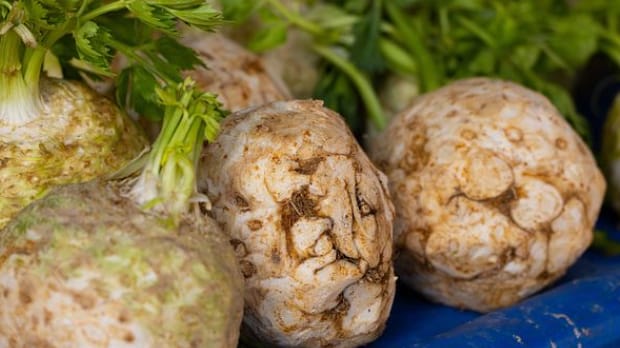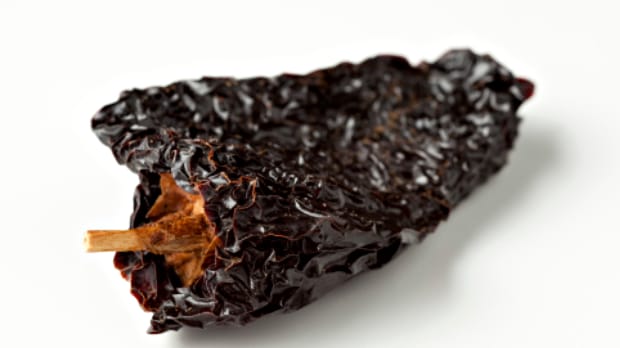What is Celeriac?
Celeriac, pronounced [seh-LER-ay-ak], or celery root is a vegetable that belongs to the celery family. It is known by various names such as celery knob, celeri-rave, turnip-rooted celery, and celery root. You can easily identify this vegetable near specialty vegetables or root crops, such as turnips and parsnips. It has a brown-to-beige rough and gnarled appearance, with a distinctive aroma that hints of celery with a pungent earthy flavor. Celeriac is usually in season from late fall through early spring. When choosing celery root, it is best to look for a smooth surface since it aids in peeling. A weight of one pound is suitable, and it should feel firm with no sign of a mushy or soft interior.
Nutritional Benefits

Today, let’s take a moment to talk about celeriac, the underrated root vegetable that packs a punch of nutritional goodness. First thing’s first, let’s talk vitamins. It is jam-packed with vitamin K, a nutrient that is essential for good bone health and blood clotting. It is also rich in vitamin C, which supports a healthy immune system and boosts collagen production for healthy skin.
But that’s not all – celeriac is also a great source of fiber. A high-fiber diet aids digestion and promotes satiety, which means it can help with weight management. Additionally, fiber has also been linked to lowering blood pressure and reducing the risk of heart disease. This root vegetable is also a low-calorie food, making it a great choice for those who want to add volume to their meals without an excessive amount of calories. And if you’re watching your carb intake, celery root is a great alternative to starchy root vegetables like potatoes. In summary, celeriac is a nutritional powerhouse that provides vitamins, fiber, and other health benefits. So next time you’re at the farmer’s market or grocery store, give this humble vegetable a chance to shine in your meals.
Types Available
Are you familiar with celeriac? It’s a type of root vegetable that can be used in a variety of dishes, and it’s also known as celery root. If you’re interested in trying out this vegetable, there are actually several different types available. First, there’s the regular type of celeriac. This is the most commonly available variety and is often used in soups, stews, and other cooked dishes. It has a slightly sweet, nutty flavor and a dense, creamy texture.

If you’re looking for something a little different, you might want to try the green celeriac. This variation has a greenish-white color and is slightly sweeter than the regular variety. It’s often used in salads and can be eaten raw or cooked.
Finally, there’s the purple celeriac. This variety has a striking purple color and a slightly sweeter flavor than the regular variety. It’s also higher in antioxidants than other types of celery root, making it a healthier choice. No matter which type of celeriac you choose, it’s a great addition to your diet if you’re looking for a healthy, flavorful vegetable to add to your meals. So go ahead and give it a try – you might be surprised at how delicious it is!
What are the Best Uses?
Are you looking for a healthy vegetable to include in your winter dishes? Look no further than celeriac! This under-appreciated root vegetable is packed with nutrients and can add depth to your recipes. Here are some of the best uses for celeriac.
Puree it: Cooked celeriac can be easily pureed to make a silky smooth side dish. Simply peel and dice the roots, then boil until tender. Mash the boiled celery root with butter, cream and some garlic for a delicious puree that pairs well with roasted meats.
Thinly slice it: Celeriac can also be thinly sliced and eaten raw in salads. Its slight sweetness pairs well with tangy vinaigrettes and crunchy nuts. Try combining it with other winter vegetables like beets and carrots for a colorful and nutritious salad.
Roast it: Another great way to prepare celeriac is to roast it. When roasted, this root vegetable has a nutty flavor and crispy texture that compliments savory dishes. Toss diced pieces with olive oil and herbs, and roast in the oven until golden brown.
Soup it: Celeriac can also make a fantastic base for hearty vegetable soups. Dice up the celery root and simmer it with broth and other vegetables like leeks, potatoes and carrots for a warm and comforting bowl.
Whether pureed, sliced, roasted or souped, celeriac is a versatile and healthy addition to your winter dishes. Give it a try today!
How do You Store Celeriac?
Celeriac, also known as celery root, is a delicious and healthy vegetable that you can store for several weeks if you handle it correctly. Storing this root vegetable is a simple process – all you need is a cool, moist environment. Here are a few tips on how to store celery root. First, remove any dirt or debris from the celeriac using a soft brush or cloth. You can also rinse it under running water, but make sure to dry it thoroughly. Next, wrap the root in a damp paper towel. This will help to keep it moist while also preventing it from getting too wet.
Place the wrapped celeriac in a plastic bag with a few small holes punched in it. The holes will allow for airflow, which is important for keeping it fresh. Store the celery root in the crisper drawer of your refrigerator. The ideal temperature for storage is around 32-40 degrees Fahrenheit.
With these simple steps, you can enjoy fresh and delicious celeriac for up to three weeks. Whether you roast it, mash it, or add it to soups and stews, this tasty vegetable is a versatile and flavorful option that is sure to become a staple in your kitchen.
How to Prepare Celeriac
If you’re not familiar with celeriac, it’s a root vegetable with a bumpy, gnarly appearance that tastes oh-so-good when prepared correctly. Here’s how you can prep and enjoy this tasty vegetable. First, give the large root a good scrub under cold running water to remove any dirt or debris.
Next, use a sharp knife to carefully cut off the top and bottom of the celeriac so that you have a flat surface to work with. Working from the top down, use your knife to carefully trim off the tough outer layer of the root, making sure to get all the bumps and nooks and crannies. Once you’ve removed the skin, the flesh inside is creamy white and ready to use–you can slice it into thick rounds and roast them for a delicious side dish, grate it and mix it with grated apple for a refreshing salad, or puree it into a silky soup.
Remember, celeriac is packed with healthy nutrients and fiber, so don’t be intimidated by its rugged exterior–with a little bit of prep, this root vegetable can really shine.
When is Celeriac in Season?
Are you excited to try this amazing root vegetable? Celeriac, also known as celery root, is a hearty vegetable that is as equally delicious and nutritious as the other popular vegetables. Now, you might be wondering which season is the best for celeriac? Well, let me tell you! It is a cool-weather crop that thrives in cold weather. This vegetable can be harvested in the late fall and early winter, making it perfect for those who want to enjoy fresh produce during the cold months. In fact, celery root is at its best during these months as the cold temperatures bring out the best flavor in it. Moreover, celeriac is a great addition to soups, stews, and roasts, adding depth and earthiness to the dish.
So, there you have it, folks! The fall and winter season are the best time to indulge in delicious celeriac. Go ahead and add this versatile and nutritious vegetable to your winter meals and relish its unique and savory taste!
Improve Your Health With Seasonal Eating
What to Serve Celeriac With?
- Roast Chicken
- Potatoes
- Apples
- Parnips
- Bacon
- Blue Cheese
- Fish
- Carrots
- Beef Bourguignon
- Seafood
What Traditional Cuisines Use Celeriac?
Celeriac is a versatile root vegetable used in a variety of traditional cuisines, including French, German, Italian, Scandinavian, and British. In French cuisine, it is often used in soups, stews, and purées. It is often boiled and served with a sauce or as part of a salad in German dishes. Italian meals use the versatile root vegetable in risotto, soups, and salads. In Scandinavian cuisine, it is often served as part of a salad or as a side dish. Celery root is often mashed and served as an accompaniment to roasts or grilled meats on British menus.
Tasty Recipes
- Celeriac Puree
- Quick Celeriac Remoulade
- Celeriac, Potato & Rosemary Gratin
- Roast Chicken with Celeriac
- Apple & Celeriac Soup
Key Takeaways
- Choose celeriac with a firm, smooth skin and avoid any with blemishes or soft spots.
- Store the root vegetable uncut, in a cool, dark place for up to 2 weeks.
- Remove the skin with a sharp knife before cooking.
- Boil, steam, mash, or roast celeriac as a side dish or as part of a main meal.
- Add this tasty root vegetable to soups and stews for an earthy flavor and creamy texture.
- Celeriac can also be eaten raw in salads or as a snack when sliced and dipped in hummus or salsa.
- Celery root is rich in fiber, vitamins, and minerals, making it a nutritious addition to your diet.
References: Phenolic composition and antioxidant capacity of celeriac (Apium graveolens var. rapaceum) and its potential application in food | Nutritional and Health Benefits of Celeriac (Apium graveolens var. Rapaceum) | Chemical composition and nutritive value of celeriac (Apium graveolens L. var. rapaceum) | Nutritional and Health Benefits of Celeriac (Apium graveolens L.): A Review</a




